ISSN ONLINE(2319-8753)PRINT(2347-6710)
ISSN ONLINE(2319-8753)PRINT(2347-6710)
Surapati Pramanik1, Sourendranath Chackrabarti2
|
| Related article at Pubmed, Scholar Google |
Visit for more related articles at International Journal of Innovative Research in Science, Engineering and Technology
In this paper, we studied the problems faced by construction workers in West Bengal in order to find its solutions using neutrosophic cognitive maps, which is the generalization of fuzzy cognitive maps. Florentin Smarandache and Vasantha Kandasamy studied neutrosophic cognitive map which is an extension of fuzzy cognitive map by incorporating indeterminacy. Construction sector plays a major role in which construction workers face many problems in their day-to-day life. Some of the problems are discussed in the present study. The major problems are working for more number of hours, staying away from home, bad habits, absence of social security, misunderstanding, arguments with partners, stress, skin problems, sexual behavior & sexual health problem, and physical health problems. Based on the expert’s opinion and the notion of indeterminacy, we formulate neutrosophic cognitive map. Then we studied the effect of two instantaneous state vectors separately on connection matrix E & neutrosophic adjacency matrix N(E).
Keywords |
| Cognitive map, connection matrix, construction workers, fuzzy cognitive map, neutrosophic cognitive map, state vector |
I. INTRODUCTION |
| Construction sector falls under unorganized sector of an economy. Unorganized laborers refer to those workers who have not been able to organize themselves in pursuit of their common interest owing to certain constraints like casual and uncertain nature of employment, ignorance and illiteracy, small and scattered size of establishment etc. Various studies found that most of the construction workers are illiterate or literate and ignorant about market conditions and labor market variations. Skilled and unskilled construction workers work with low wages. They are working under unsecured environment or work culture. They are migrating from different regions and states leaving their native villages in search of daily job. They have maximum mobility because of the nature of their work. These laborers are engaged in huge industrial constructions, residential flat constructions, city beautification works. |
| Political scientist Robert Axelrod introduced cognitive maps (CMs) in 1976 and applied in political science [2]. Axelrod developed CMs, i.e. signed digraphs designed to capture the causal assertions of an individual with respect to a certain domain and then applied them in order to analyze the effects of alternative, e.g. policies, business decisions, etc. upon certain goals. A cognitive map comprises of only two basic types of elements namely, nodes and edges. Nodes represent variable concepts and edges represent causal connections. In the field of cognitive maps, the concept of fuzzy set theory introduced by Zadeh [17] was introduced by B. Kosko [6] in 1986. Fuzzy cognitive maps are widely used in ([3]-[5], [8]-[9], [11], [13]-[15]). |
| F. Smarandache and Vasantha Kandasamy ([10], [12] studied neutrosophic cognitive map (NCM) which is the extension of fuzzy cognitive map by incorporating indeterminacy. The concept of neutrosophic logic [7] plays a vital role in several real life problems like law, information technology, stocks and share etc. Construction laborers’ problem in India is one of the major problems in India. Nowadays, construction sector plays a major role in which construction workers face so many problems in their day-to-day life. Some of the problems are discussed in the present study. A study was done among 100 construction workers in West Bengal. Major problems of construction workers are working for more number of hours, staying away from home, bad habits, absence of social security, misunderstanding, argument with partners, stress, skin problems, sexual behavior and sexual health problems, physical health problems. |
| Rest of the paper is presented in the following way. Section II describes the preliminaries of NCM. Section III presents the method of finding hidden pattern. Section IV is devoted to modeling the problems of the construction workers using NCM. Section V presents conclusions. |
II. PRELIMINARIES |
| Definition: 2.1 |
| Neutrosophic graph: A neutrosophic graph refers to a graph in which at least one edge is an indeterminacy denoted by dotted lines. |
| Definition: 2.2 |
| Neutrosophic directed graph: A neutrosophic directed graph is a directed graph which has at least one edge to be an indeterminacy |
| Definition: 2.3 |
| Neutrosophic oriented graph: A neutrosophic oriented graph is a neutrosophic directed graph having no symmetric pair of directed indeterminacy lines. |
| Definition: 2.4 |
| Neutrosophic Cognitive Map (NCM): An NCM refers to a neutrosophic directed graph with concepts like policies, events etc. as nodes and causalities or indeterminate as edges. It reflects the causal relationship between concepts. Let us suppose that C1, C2, …, Ck represent k nodes. Also let each node be a neutrosophic vector from neutrosophic vector space V. So a node Cj ( j = 1, 2, …, k) can be represented by (x1, x2, …, xk ) where xi’s are zero or one or I (I represents the indeterminacy) and xi = 1 means that the node Ci is on state and xi = 0 implies that the node is in the off state and xi = I means the nodes state is an indeterminate at that time or in that situation. Let Cm and Cn denote the two nodes of the NCM. The directed edge from Cm to Cn represents the causality of Cm on Cn called connections. Every edge in the NCM is weighted with a number in the set {-1, 0, 1, I}. Let mn α denote the weight of the directed edge CmCn, mn α ∈{–1, 0, 1, I}. mn α = 0 if Cm does not have any effect on Cn, mn α = 1 if increase (or decrease) in Cm causes increase (or decreases) in Cn, mn α = –1 if increase (or decrease) in Cm causes decrease (or increase) in Cn. mn α = I if the relation or effect of Cm on Cn is an indeterminate. |
| Definition: 2.5 |
| NCMs with edge weight from the set {-1, 0, 1, I} are called simple NCMs. |
| Definition: 2.6 |
| Let C1, C2, …, Ck be the nodes of a NCM. Let the neutrosophic matrix N(E) be defined as N(E) = ( ) mn α where mn α is the weight of the directed edge CmCn, where mn α ∈{–1, 0, 1, I}. N(E) is called the neutrosophic adjacency matrix of the NCM. |
| Definition: 2.7 |
| Let C1, C2, …, Ck denote the nodes of the NCM. Let A = ( 1 2 k α ,α ,...,α ) where m α ∈{0, 1, I}. A is called the instantaneous state neutrosophic vector and it denotes the on – off – indeterminate state position of the node at an instant |
 |
| An NCM is said to be acyclic if it does not possess any directed cycle. |
| Definition: 2.9 |
| An NCM having cycles is said to have a feedback. When there exists a feedback in the NCM i.e. when the causal relations flow through a cycle in a revolutionary manner the NCM is termed a dynamical system. |
| Definition 2.10 |
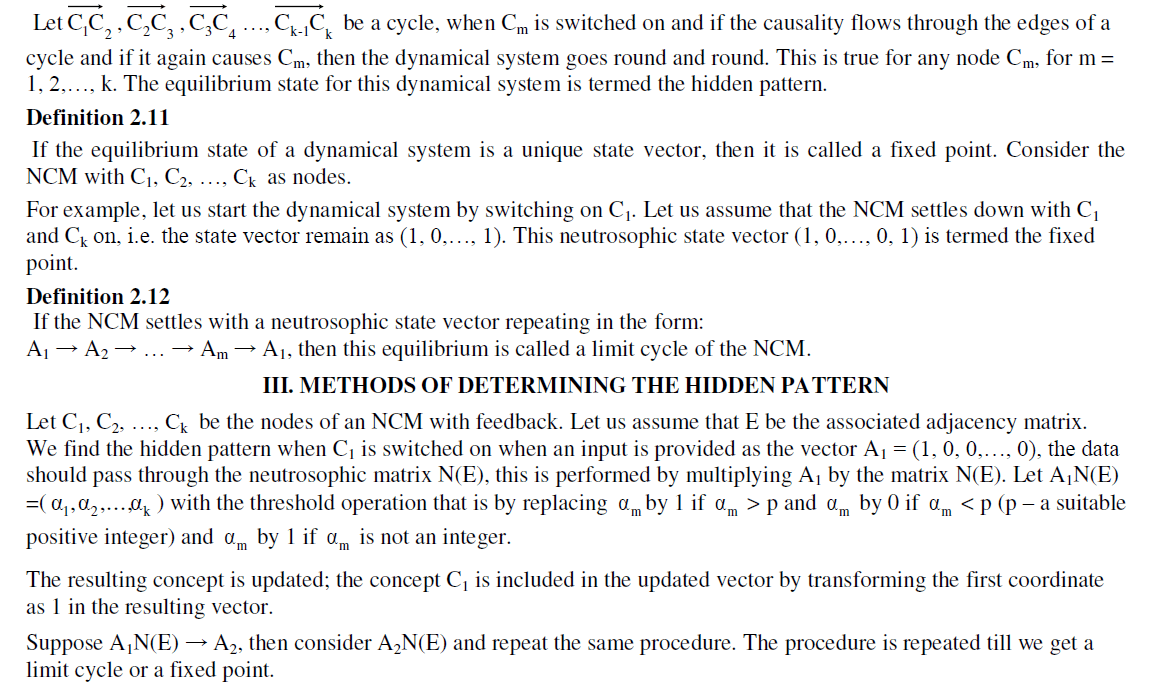 |
IV. MODELING OF THE PROBLEMS OF THE CONSTRUCTION WORKERS IN WEST BENGAL USING NCM |
| To assess the impact of problems faced by construction laborers in the age group 20-45 years, data was collected from 100 construction works in West Bengal. Based on linguistic questionnaire and the expert’s opinion, we have considered the following concepts as {C1, C2, …, C9, C10}. The following nodes are considered as the main nodes for the problem. C1 -Work for more number of hours: It means working more than eight hours. The construction workers have to work more than eight hours to earn money for their livelihood. |
| C2 - Staying away from home: The construction workers are generally migrant laborers and they have to live in tents near the construction site temporarily. So they have to stay away from home. |
| C3 -Bad habits: It includes smoking (bidi, cigarette, ganja, etc.), consumption of gutka, alcohol, and addiction of drugs. |
| C4 -Absence of social security: The construction workers do have no social security and benefits in terms of labor welfare measures and provisions. They are deprived of having provisions like pension and insurance schemes, maternity leave, accident and death claims, concession of loans and financial aid for children's education and medical needs. They don't have recreation facilities, availability of drinking water, toilets, bathrooms, canteens etc. |
| C5 -Misunderstanding: It is a situation where something is not understood properly. |
| C6 - Arguments with partners: A quarrel or disagreement between spouses or coworkers. |
| C7 -Stress: Stress occurs when a person’s brain feels a threat from bursts of hormones. Certain triggers, such as heavy work load, a job loss or death can cause these threats. Symptoms such as back pain, chest pain, anxiety and muscle tension are just a few physical signs of stress. Since construction workers have to work more than eight hours, they easily feel heavy work load. In general, they do not get overtime rates for excess work. In case of accidents, there exists, in general, no provision for financial and medical aid. Sometimes they observe deaths of their coworkers due to accidents during the working hours which produce tension but nobody owns the responsibility. Every construction worker feels stress at one time or another. |
| C8 - Skin problems: Construction laborers handle cement which has constituents to create irritant, contact dermatitis (redness, itching, pain at the site of the contact with the cement or the subjects complaining of itching due to rubber gloves were involved), corrosive effect and sanitization, leading to allergic contact dermatitis from ingredients such as chromium. |
| C9 - Sexual behavior & sexual health problems: Little study [1] is reported in the literature about the sexual behavior or health of the migrant workers in India. A human being’s sexual behavior is the product of not only by the biological, psychological or cultural factors but also by his/her immediate affiliation to the various groups he/she belongs to. Sex refers to a personal affair of an individual. Sexuality exists in reality and is very intimately linked with broad societal factors as well as the characteristics of an individual’s community, work/school, family and societal networks [16]. It is a difficult task to objectively study the sexual behavior of a human being or a community. Individual’s ignorance about the potential health threats during sexual behavior is one of the principal reasons for fast spread of Sexually Transmitted Diseases (STDs), Human Immunodeficiency Virus / Acquired Immunodeficiency Syndrome (HIV/AIDS) and other sexual health problems. Construction workers are victims of multiple complications due to unstable nature of their employment, vulnerable living conditions, dearth of health care facilities and lack of health awareness. Akram’s study [1] on migrant construction workers revealed that they are marginalized people in urban spaces and more susceptible to sexual health problems. |
| C10 - Physical health problems: It includes respiratory diseases from inhaling dust, muscular skeletal disorder, injuries from heavy load, noise induced hearing loss. |
| However more number of conceptual nodes can be added by the expert or investigator. Now we give the directed graph as well as neutrosophic directed graph in the following figures Fig.1 and Fig.2. Fig. 1 gives the directed graph with C1, C2, …, C9, C10 as nodes and Fig.2 gives the neutrosophic directed graph with the same nodes. |
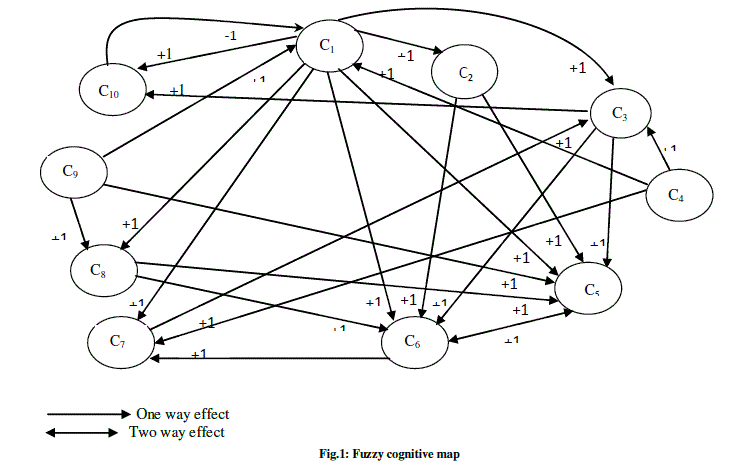 |
| The connection matrix E related to the graph (see Fig.1) is given by the following matrix: |
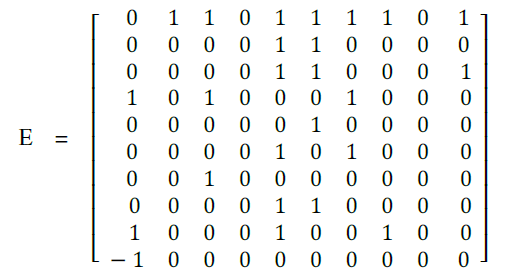 |
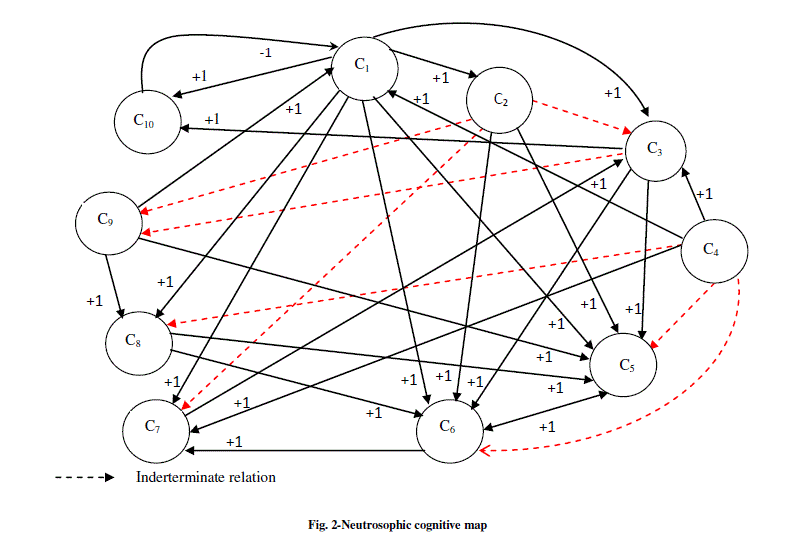 |
| The corresponding neutrosophic adjacency matrix N(E) related to the neutrosophic directed graph (see Fig.2) is given by the following matrix: |
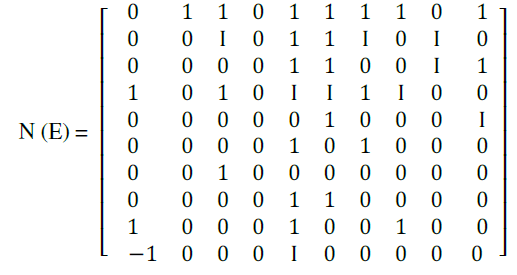 |
IVA. Effect of two instantaneous state vectors separately on connection matrix E & neutrosophic adjacency matrix N(E) |
| Case-I: |
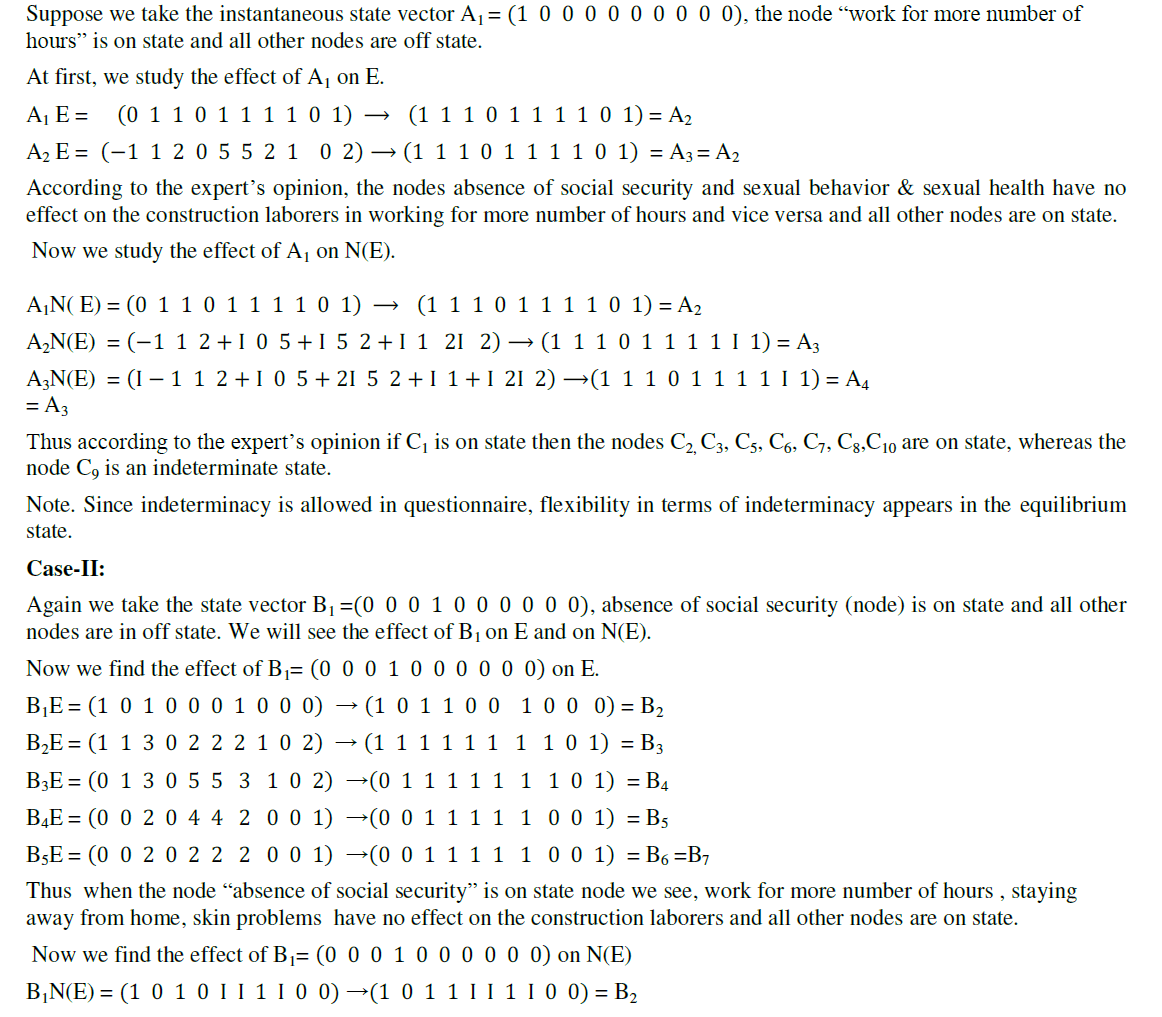 |
 |
V. CONCLUSION |
| The problems of construction workers were studied based on NCM. Based on NCM, it is noticed that if the construction laborers work for more number of hours then they have to stay away from home for more number of days and other factors like bad habits, misunderstanding, argument with partners, stress, skin problems, physical health problems will increase, whereas sexual behavior & sexual health problems is in indeterminate state. Again, when absence of social security increases or is on state, the following nodes namely, work for more number of hours, staying away from home, skin problems, sexual behavior & sexual health are in indeterminate states, whereas misunderstanding, addiction of drugs, argument with partners, stress and health problems will increase or are on states. If new situation arises in the construction sector, new concepts need to be incorporated for modeling the construction workers problems and that can be easily done by introducing new nodes. |
| However, government should implement “Regulation of Employment & Conditions of Service Act, 1996 [18] to protect the rights of construction workers and government should provide them education regarding their profession in order to avoid professional hazards. |
References |
|